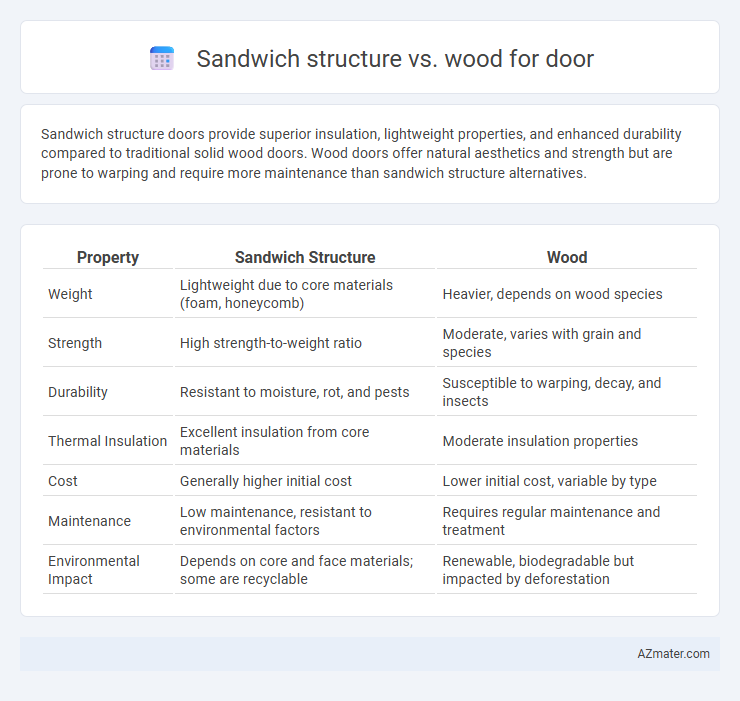Sandwich structure doors provide superior insulation, lightweight properties, and enhanced durability compared to traditional solid wood doors. Wood doors offer natural aesthetics and strength but are prone to warping and require more maintenance than sandwich structure alternatives.
Table of Comparison
| Property | Sandwich Structure | Wood |
|---|---|---|
| Weight | Lightweight due to core materials (foam, honeycomb) | Heavier, depends on wood species |
| Strength | High strength-to-weight ratio | Moderate, varies with grain and species |
| Durability | Resistant to moisture, rot, and pests | Susceptible to warping, decay, and insects |
| Thermal Insulation | Excellent insulation from core materials | Moderate insulation properties |
| Cost | Generally higher initial cost | Lower initial cost, variable by type |
| Maintenance | Low maintenance, resistant to environmental factors | Requires regular maintenance and treatment |
| Environmental Impact | Depends on core and face materials; some are recyclable | Renewable, biodegradable but impacted by deforestation |
Introduction to Door Materials: Sandwich Structure vs Wood
Sandwich structure doors consist of composite materials with core layers such as foam or honeycomb, providing superior insulation and lightweight durability compared to traditional wood doors. Wood doors offer natural aesthetics, excellent strength, and acoustic properties but require maintenance to prevent warping and decay. Choosing between sandwich structure and wood depends on factors like thermal performance, weight, durability, and design preferences.
Key Features of Sandwich Structure Doors
Sandwich structure doors feature a core material like polyurethane foam, mineral wool, or honeycomb cardboard, offering superior thermal insulation, soundproofing, and lightweight durability compared to traditional wood doors. These doors have high resistance to moisture, warping, and insect damage, making them ideal for environments requiring low maintenance and long-lasting performance. The multi-layer construction enhances strength and impact resistance while providing excellent energy efficiency, surpassing solid wood in both functionality and sustainability.
Characteristics of Solid Wood Doors
Solid wood doors provide superior durability and natural insulation due to their dense cellular structure, offering excellent thermal and acoustic properties. Unlike sandwich structure doors, solid wood is less prone to warping and delivers a unique, rich aesthetic with distinct grain patterns and natural color variations. These doors require regular maintenance to preserve their strength and appearance, making them ideal for traditional and high-end interior applications.
Comparing Strength and Durability
Sandwich structure doors offer superior strength due to their multi-layer composition, combining a rigid core with durable outer materials that resist warping and impact better than traditional wood doors. Wood doors, while aesthetically pleasing and naturally insulating, are more susceptible to swelling, cracking, and damage from moisture and pests over time. The engineered nature of sandwich doors ensures enhanced durability and longevity, making them a more reliable choice for environments with heavy use or fluctuating conditions.
Thermal and Acoustic Insulation Properties
Sandwich structure doors offer superior thermal insulation due to their multi-layer composition, which typically includes insulating foam cores that reduce heat transfer significantly compared to solid wood doors. In terms of acoustic insulation, sandwich doors excel by incorporating dense core materials and airtight seals, effectively dampening sound transmission better than traditional wooden doors. While wood provides natural insulation properties, sandwich structure designs achieve enhanced energy efficiency and noise reduction, making them ideal for modern thermal and acoustic performance requirements.
Aesthetic Appeal and Design Flexibility
Sandwich structure doors offer high aesthetic appeal with sleek, modern finishes and customizable surface textures, enhancing contemporary interior design. Wood doors provide timeless beauty and natural grain patterns, appealing to classic and rustic styles while allowing intricate carvings and varied stains. Design flexibility is greater in sandwich structures due to customizable core materials and laminated surfaces, whereas wood doors excel in organic shapes and traditional craftsmanship.
Cost Analysis: Sandwich Structure vs Wood
Sandwich structure doors typically offer superior cost-efficiency compared to solid wood doors due to lower material and manufacturing expenses. Wood doors, while providing natural aesthetics and durability, often incur higher costs for maintenance and are susceptible to environmental damage, increasing long-term expenses. The sandwich structure's composite materials reduce installation and upkeep costs, making them a more budget-friendly option in both residential and commercial applications.
Environmental Impact and Sustainability
Sandwich structure doors typically use a combination of materials like metal and foam cores, which offer better insulation but often involve synthetic components with higher environmental footprints. Wood doors are renewable, biodegradable, and can be sourced sustainably, making them a more eco-friendly option with a lower carbon footprint. Choosing wood supports forest management practices and reduces reliance on non-renewable resources compared to sandwich structure doors with synthetic materials.
Installation and Maintenance Considerations
Sandwich structure doors offer easier installation due to their lightweight composition and standardized panel sizes, reducing labor time compared to traditional wood doors that often require precise fitting and adjustments. Maintenance for sandwich doors is minimal, as their synthetic surfaces resist warping, moisture, and pests, unlike wood doors that demand regular sealing, painting, or varnishing to prevent decay and maintain appearance. Choosing sandwich structure doors enhances durability and lowers long-term upkeep costs, making them ideal for environments with fluctuating humidity and temperature.
Choosing the Best Door Material for Your Needs
Sandwich structure doors offer superior insulation, lightweight properties, and resistance to warping compared to traditional wood doors, making them ideal for energy-efficient and climate-controlled environments. Wood doors provide natural aesthetics, durability, and the ability to be custom-carved, appealing to those who prioritize classic design and strength. Selecting the best door material depends on balancing factors like thermal performance, maintenance requirements, budget, and stylistic preferences.

Infographic: Sandwich structure vs Wood for Door
 azmater.com
azmater.com